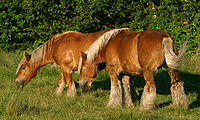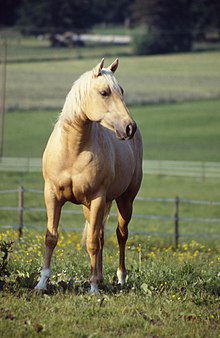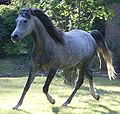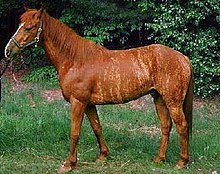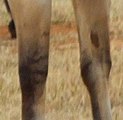Coat colors of horses
The currently known equine coat color are primarily a result of breeding intervention by the people of the horse , like other domesticated animals favored and differences as something special further bred.
The historically grown names name the colors on the basis of their appearance. The genetics of horse colors deals with the genetic basis .
Original coat colors
As herbivores and prey animals, wild horses are dependent on attracting as little attention as possible. This results in a uniform camouflage color , as can be found in many herd-forming prey. Wild Przewalski horses had a color that, depending on their origin, ranged from a lighter to a darker fawn.

Even with wild horses from the Pleistocene and at the time when copper was the predominant material, there was the genotype of the black horse, brown and in Europe but not in Siberia also tiger piebalds. In a genetic test, of 31 examined prehistoric wild horses from Siberia, Eastern and Western Europe, 18 were brown, seven black and six tiger piebalds . It is assumed that the folding was also present at the same time. However, this has not yet been verified as this gene has not yet been genetically identified. So it was possible that it was brown fallow, mouse fallow and tiger pied falcon. In a further study, the tiger pancake gene was not examined, in Siberia and Eastern and Central Europe only the brown genotype was detected, the black also occurred in the area of Spain.
The assumption that the coloring of the animals is uniform so that individual specimens do not stand out from the herd is demonstrably not true to the extent that was assumed. The camouflaging color varies depending on the habitat in order to stand out as little as possible from the habitat. The fawn color of the Przewalski horse and other wild equids such as the onager and the kulan should therefore come very close to the color of the ancestors of our domestic horses. Even today, wild horses often have an inconspicuous coat color; Depending on where the respective horse species lives, brown tones are predominant.
Coat colors as a result of breeding work
In the 3rd millennium BC, with the beginning of the domestication of horses, the number of horse colors increased.
Due to the breeding performance, there are a whole range of colors in horses today. Many of them are found in almost all races, but some are found in very few races. Conversely, there are also certain breeds in which there are only a few color variants.
In general, a distinction is made between the colors of the horse in relation to the long hair , i.e. mane and tail, and the short hair, i.e. the coat . Today's German color names are a cultural agreement that has evolved over time. They are based on definitions that describe the phenotype , i.e. the appearance of horses, and do not claim to present genetically correct relationships. Due to the very complex interaction of the different genes, horses can be assigned a color based on their external appearance, although there are great genetic differences between them , known as genotypes . The coat color is primarily determined by the amount of pigments. More precisely, horses only have two color pigments - eumelanin for black and pheomelanin for red markings.
The exact genetic relationships in the coloring of the fur and the eyes of the horses are explained in the article Genetics of Horse Colors .
It is not uncommon for a breed to be characterized by a specific coat color. For example, Frisians used to be found as piebalds, molds and foxes, but today they are called “the black pearls” because only black horses are allowed to be included in the stud books . Purebred Arabians, for example, may only appear as clear colors without piebalds.
The individual coat colors
The color of the coat that a foal has when it is born does not necessarily have to stay that way. In most cases the end result will be darker in the adult horse. A well-known exception to this rule is, for example, mold, which gets lighter and lighter as you grow up. Even the winter coat and summer coat of an individual horse sometimes differ significantly from one another.
Black
The classic black horse has both black long hair and black fur. Hooves and eyes are dark, markings disregarded. In addition to the "constant" black horses, which have black fur in every season of the year (shiny black horses or blue black horses), there are also summer black horses, which get a brownish or reddish coat in winter, and winter black horses, which have a brownish, grayish color (Kohlrappen) or in summer wear reddish fur.
Foxes (cabbage foxes) , brown ones (black and brown) and smoky blacks can be so dark that they cannot be clearly distinguished from black horses.
Brown
The brown has reddish to brownish fur, black legs and mostly black ear tips. He also wears a black mane and a black tail. The eyes are light to dark brown and the hooves dark, unless they are marked.
Browns come in all possible shades. So there are black-brown, dark-brown, red-brown, maroon, brown and light-brown. In addition, depending on the gene on the agoutilocus, the black is differently widespread.
Fox
The fox has brownish, reddish or yellowish fur and usually the same color, but also lighter, long hair. The hooves are dark, the eyes dark to light brown.
The fox comes in many different shades: light fox, copper fox, red fox, dark chestnut, cabbage fox and fox. A distinction is made according to the lightness or darkness of the fur.
The following horses can look like foxes although genetically they are of a different color:
- Rappwind- colored are gray to chocolate brown
- Bustards are often indistinguishable from a normal fox.
Light fox
Haflinger mare with foal
A special feature of the fox is the frequent appearance of lighter manes and tails. Such a horse, in which the mane is either only a few shades lighter than the fur or blond to white, is called a light fox . Depending on the brightness of the top hair, one speaks of the bright light fox, dark light fox or cabbage fox and other variants.
The same appearance can occur with dark palominos . Browns with the wind color gene also look like light foxes and black horses with the wind color gene can look like dark light foxes.
Isabell, Palomino
The name Isabell is usually used synonymously in German-speaking countries and mainly the name Palomino for the same color internationally . As isabellfarben refers to a by the Cream gene -related genetic brightening the fox . With this coloration, the short hair of the body is yellow to golden yellow, while the long hair of the mane and tail is cream-colored or white to silver. The horses' eyes are brown. A distinction is made in the conventional naming of different varieties: Isabell with duller, rather yellowish-colored short hair and gold isabell with gold-shining short hair.
Similar colors: Horses of the color Gold Champagne differ from Isabelle by their pink skin with dark dots. Foxes lightened by Pearl differ from Isabelles in that their long hair is the same color as the rest of the fur. Fox falcons have a brown eel line in the middle of the mane and on the back.
Darker palominos look like light foxes, even though they are genetically Isabelle.
Dun
Black fallow: Konik
Wild-type bay dun: fjord horse
Traditionally, all horses with light, sandy or gray fur and black or dark brown mane and tail were referred to as duns . A sandy-colored horse with a black mane is called a brown falcon or simply fallow, a gray horse with a black mane is called a mouse falcon, and a sandy-colored horse with a brown mane is called a fox fallow.
In fact, this phenomenon occurs due to several different genes.
The following horses look like a brown falcon:
- The real brown falcon , recognizable by the two-colored mane, the dark eel line on the middle of the back and sometimes also zebra stripes on the legs and shoulder cross.
- Earth- colored horses : monochrome black mane, no wild color markings.
- Amber Champagne: Horses of this color differ from the dun with their monochrome, chocolate-brown mane and tail and their pink skin with dark spots.
The following horses act like mousefolds:
- The real mouse fallow , recognizable by the two-tone mane, the dark eel line on the middle of the back and sometimes also zebra stripes on the legs and shoulder cross.
- Classic Champagne: Horses of this color differ from the mouse fallow by their monochrome, chocolate-brown mane and tail and pink skin with dark dots.
- Black horses lightened by Pearl differ from falcons in that their long hair has the same light gray color as the rest of the fur.
The following horses act like fox falcons:
- The real fox fallow , recognizable by the two-colored mane, the brown eel line on the middle of the back and sometimes also brown zebra stripes on the legs and shoulder cross.
- Horses of the color Gold Champagne and Isabellen differ from the chestnut fallow by their consistently white or lighter mane.
- Foxes lightened by Pearl differ from Fallows in that their long hair has the same sand color as the rest of the fur.
White horse: white horses
White-born Appaloosa
By far the largest proportion of completely white horses are real gray horses that are a few years old.
In addition to gray horses, there are other white horses that, unlike white horses, all have pink or pale skin. These include horses doubly lightened by the horse's cream gene , piebalds , in which the white component has spread so far that the whole animal is white and the dominant white color in the horse .
Some black horse- colored horses can look similar to an apple mold .
A horse that is completely moldy can still have small colored dots. If they are black, it is a fly mold. If the remaining spots are brown / reddish, it is trout mold.
Graver-haired horses - red mold, brown mold, blue mold
Quarter Horse , graver-haired fox
Criollo , graver-haired brown
Traditionally, every horse that had colored - i.e. brown, black or sand-colored - hair mixed with white hair was referred to as spiky-haired and indiscriminately, depending on the underlying color, also red mold (or fox mold), brown mold (sometimes also red mold) or blue mold (black mold) called.
However, this appearance can be caused by various genes:
- Burin-haired horse or permanent gray horse : differs from real gray in its dark face and legs. The amount of white hair changes with the seasons, but the horse does not get lighter with life.
- Mold : Mold foals are born dark and gradually get more and more white hair. Their heads are usually lighter than the body.
- Rabicanos are especially light in the chest area and on top of the tail, legs, hips, shoulders, head and neck remain dark.
- Varnish roan : A dark V- mark remains on the face as the horse becomes lighter in the course of its life, dark fur extends to the knees and hocks, dark spots at the base of the legs.
- Sabino : There is always at least one blaze, usually a lantern, on the face. Usually there are also badges on the legs. The mane and tail tend to turn white when prickly hairs appear.
Check
Tobiano ( Paint Horse )
Sabino ( Tinker )
A piebald is a horse whose body hair, in addition to a basic color, has clearly delimited white areas that go beyond the extent of normal markings .
While piebalds are undesirable for most horse breeds in our time and are not permitted for breeding , piebalds used to be popular horses because of their specialty. An indication of this is the famous picture of Napoleon on the Sankt-Bernhard-Pass , of which two versions exist: once Napoleon is sitting on a white horse, once on a piebald.
The tiger piebald is contrasted with all other patterns. With the same gene, a number of different check patterns develop, with small round dark spots on a white background or small round white spots on a dark background.
The remaining piebalds are grouped together as plate checks , in which the Tobiano is contrasted with the remaining patterns, which are known as Overos.
Tobiano: The legs are usually white or have white markings, the head usually does not have more white markings than unchecked horses. The eyes are mostly dark. The white usually crosses the topline somewhere and the spots lead from above to below.
There are three known types of Overos: The Frame Overo , the Splashed White Overo and the Sabino Overo , whereby the Sabino drawing is again caused by several different genes.
Frame Overo: The back line is always colored throughout. The face usually has larger white markings while the legs are mostly dark but can sometimes have white socks. The color varies between almost white and almost colored types. Homozygous animals are completely white and not viable.
Splashed White Overo: The horse looks like it has been dipped in white paint. The back and ears are colored, the legs and lower half of the body are white. Many Splashed White Overos are deaf.
Sabino Overo: usually have four white legs, the white then spreads upwards in small speckles. Some Sabinos have blue eyes, others have brown eyes. If the pattern is only slightly pronounced, they only have white legs and a blaze, if the pattern is more pronounced. Others are almost completely white or very easily confused with the other forms of spotting. It is believed to be due to several different genes. Sometimes the "lethal white" gene also appears in Sabinos.
As Toveros horses are designated whose Scheckungsmuster do not fit into the above pattern.
As Pintaloosas is called horse where the Tobianoscheckung is combined with the leopard markings.
Rare colors and patterns
Brindle
Brindle is a rare and showy coat color. The fur pattern is reminiscent of the fur of brindle boxers. The horses have lighter or darker stripes on the basic color, which are mainly shown on the torso and neck, but can also be distributed over the whole body. Sometimes only one half of the body is streaked. The cause of Brindle has not yet been researched. However, since Brindles are descended from normal colored parents and their markings are only partially reproducible, inheritance is not only dependent on one gene. Genetic tests on two brindle horses have shown that they have two sets of genes. The lighter parts of the fur are controlled by one set of genes, the darker by a second.
Lacing
Lacing is a rare pattern of fur (less common than brindle). She describes lines on horseback that are shaped like giraffe spots. The white markings are reminiscent of fur that has regrowed white due to fungus. Since the drawing also occurs in healthy, newborn foals, no connection can be seen here. Inheritance is unknown. The drawing can also appear in a dark form (black pattern on brown fur) and is then even more reminiscent of the giraffe pattern.
Mosaic Pattern
This type of check without white markings is extremely rare. The horses are brown with large black spots. So far only a few horses drawn in this way are known, e.g. B. an Icelandic mare named Miljon fra Grund. In their case, both parents and all siblings are colored normally, which is why it is assumed that the mutation is not reproducible .
Eel line, shoulder cross and other badges
Some horses, mostly duns, but occasionally also bay or dark foxes, still have the primitive markings of their ancestors. These can appear as zebra stripes on the legs or in the form of a dark stripe that runs along the back and is called a dorsal line or eel line , or as stripes that run down the shoulders, usually forming a so-called shoulder cross with an eel line . These characteristics are seldom seen in ponies, but often seen in donkeys.
Another type of markings are also innate, white areas in the horse's coat because they are pigment-free. They appear in various forms on the forehead and are then called blaze , or on the legs of horses. In principle, these white markings can appear on all horse breeds, but the breeding regulations of some breeds prohibit them.
In addition, the individually different fur swirls in horses are called badges.
Fur colors and superstition
In the Middle Ages, different character traits were associated with different coat colors.
"Choose the black horse,
you want fire,
duns are good,
are never too expensive,
molds are
often born sluggish,
foxes
have ears behind,
brown
ones,
they don't shine too much,
are reliable, wiry, sinewy!"
and
“
Don't even buy four white feet !
Don't keep
three white feet
too long!
Two white feet
Give it to a friend!
A white foot
keep it for a lifetime! "
The black horse was also seen as a bad luck charm and the gray horse as a sign of purity.
See also
- Genetics of horse colors
- Coat color - Provides an overview of all species
Individual evidence
- ↑ M. Pruvost, R. Bellone, N. Benecke, E. Sandoval-Castellanos, M. Cieslak, T. Kuznetsova, A. Morales-Muñiz, T. O'Connor, M. Reissmann, M. Hofreiter, A. Ludwig : Genotypes of predomestic horses match phenotypes painted in Paleolithic works of cave art. In: Proc Natl Acad Sci US A. 108 (46), 2011 Nov 15, pp. 18626-18630. Epub 2011 Nov 7. PMID 22065780
- ↑ a b Arne Ludwig, Melanie Pruvost, Monika Reissmann, Norbert Benecke, Gudrun A. Brockmann, Pedro Castaños, Michael Cieslak, Sebastian Lippold, Laura Llorente, Anna-Sapfo Malaspinas, Montgomery Slatkin, Michael Hofreiter: Coat Color Variation at the Beginning of Horse domestication. In: Science. 324 (5926), 2009 Apr 24, p. 485. PMID 19390039
- ↑ YES Lusis: striping patterns in domestic horses. In: Genetica. Volume 23, Number 1, pp. 31-62 / December 1943, doi: 10.1007 / BF01763802 .
















